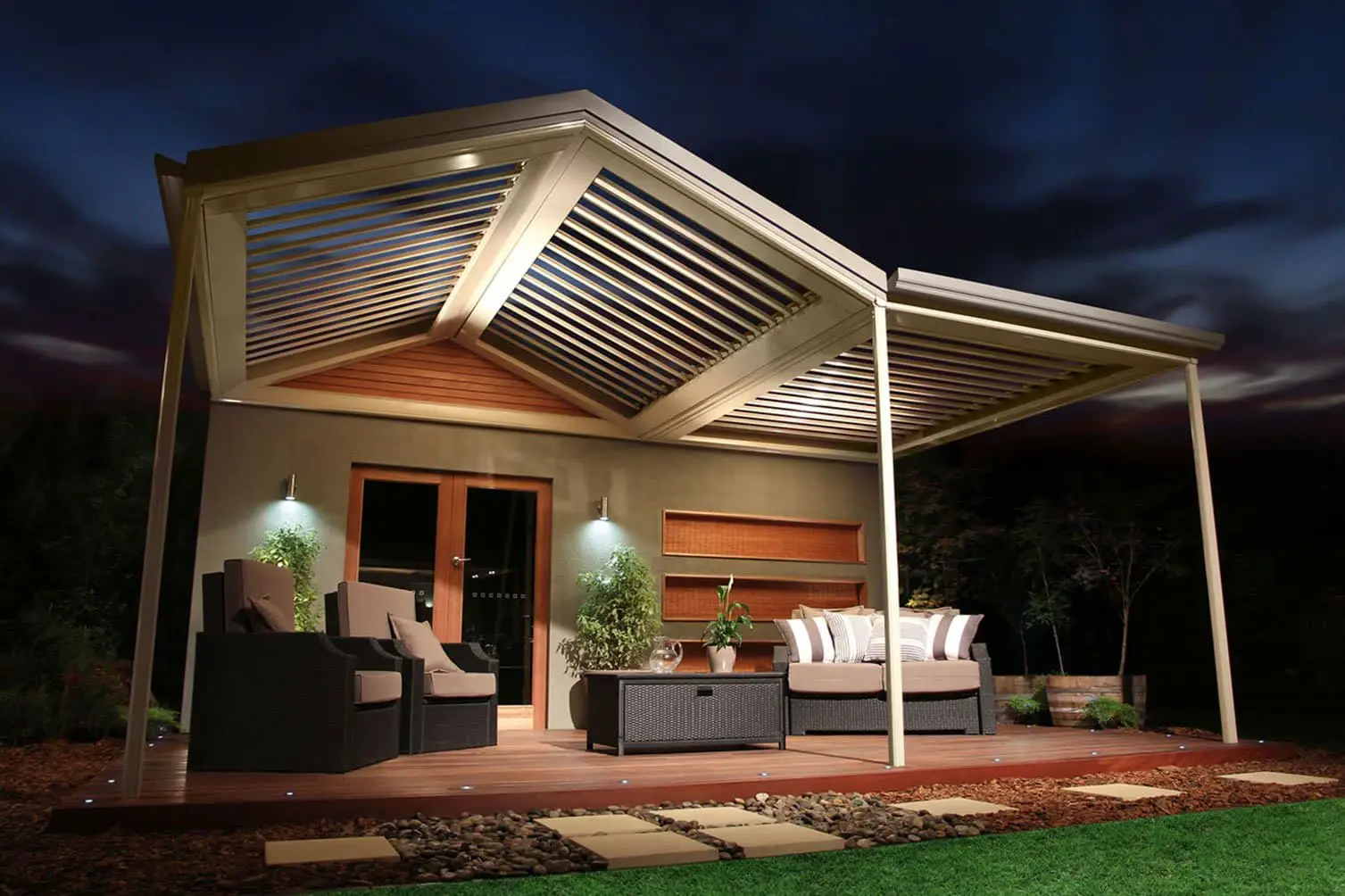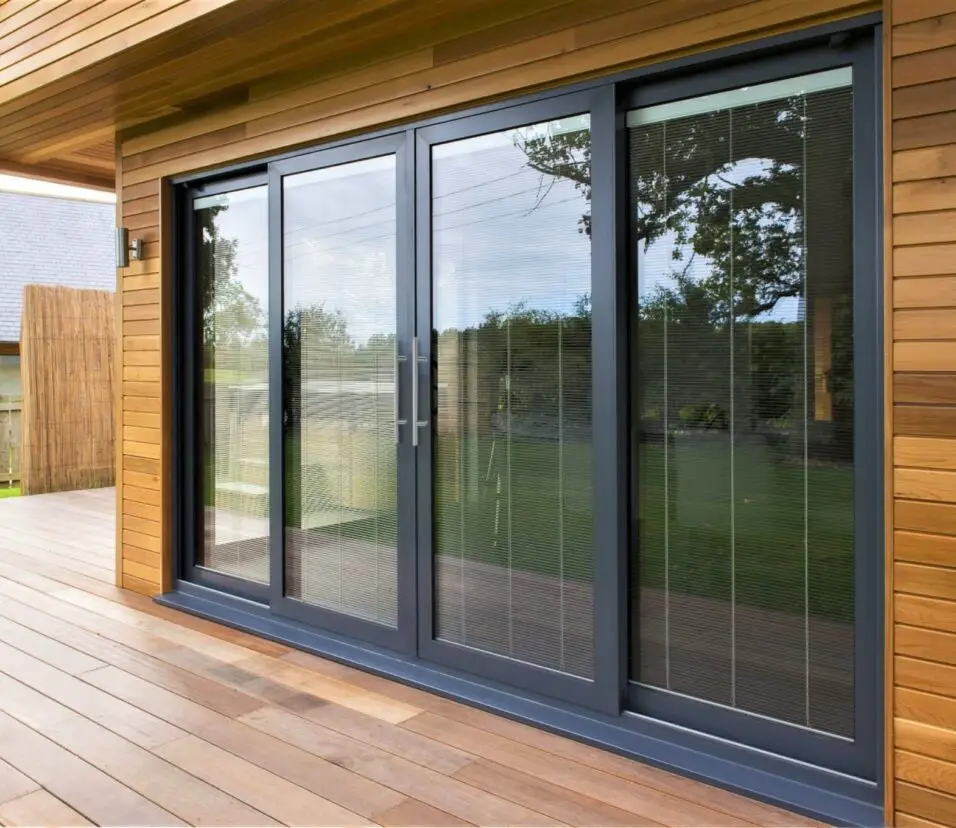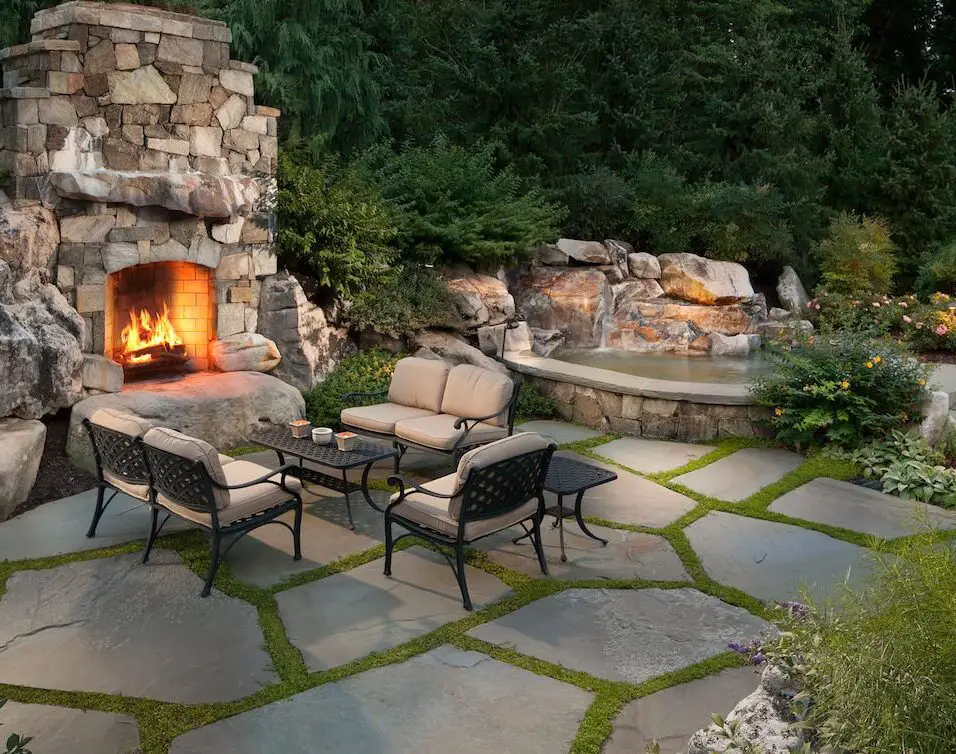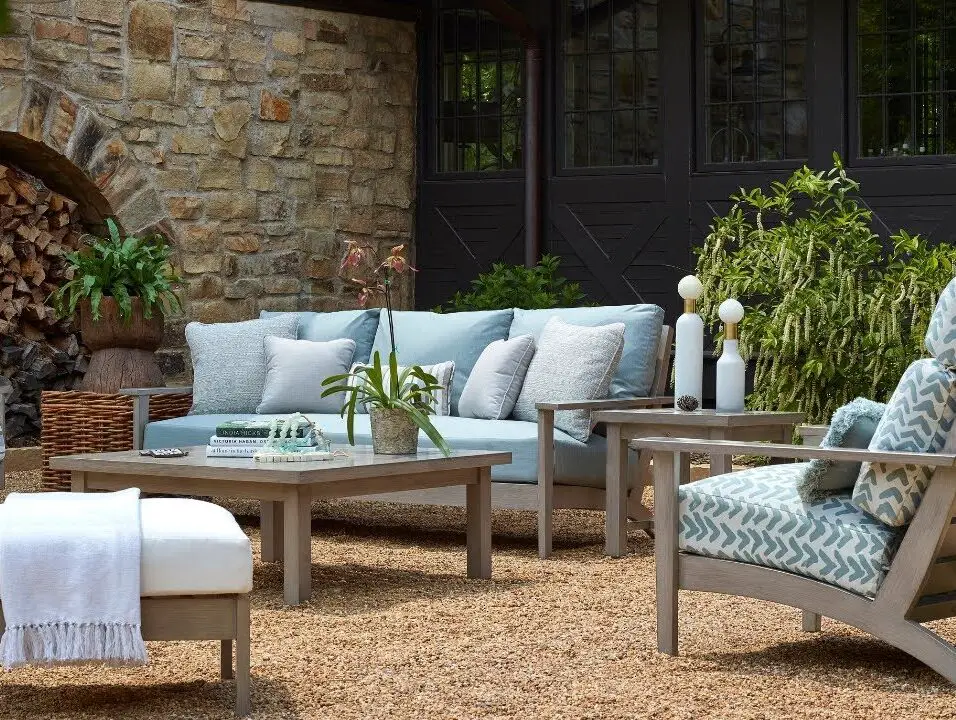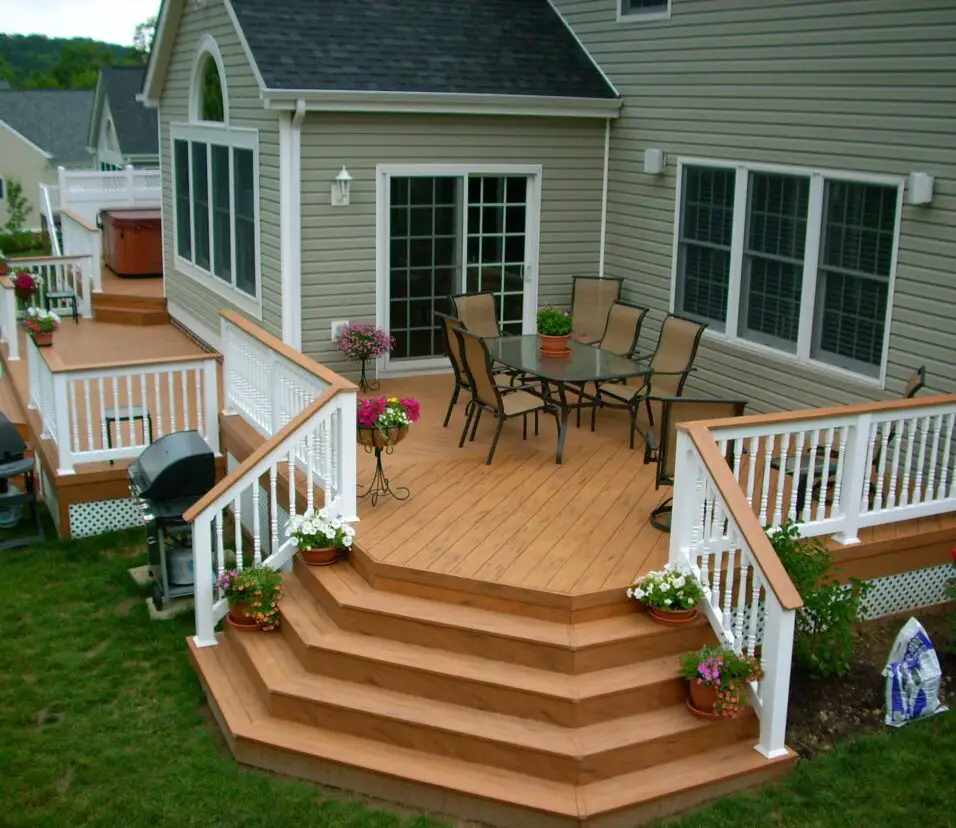How To Build A Roof Over A Patio
Introduction
How To Build A Roof Over A Patio: Clear instructions, complete with illustrations and helpful tips, you through each phase of the project. From gathering the necessary tools and materials to understanding key construction techniques, we’ll help you avoid common pitfalls and ensure that your fix patio roof is not only aesthetically pleasing but also safe and sturdy. These translucent panels offer protection while allowing natural light to filter through. They are lightweight, shatterproof, and ideal for creating a bright and inviting covered space.
Whether you’re planning to construct a small roof for a cozy patio corner or a larger one to accommodate outdoor gatherings, we’ve got you covered. So, grab your notebook and get ready to turn your patio into a remarkable oasis where you can make lasting memories with family and friends, all while enjoying the comfort and beauty of your skillfully crafted patio roof. They offer shade and protection from the sun and light rain while allowing you to adjust the coverage as needed.
The Cover various design options, ranging from simple lean-to structures to more complex gable or hip roofs, allowing you to choose the style that best complements your home’s architecture and your personal taste. We’ll delve into essential considerations, such as checking local building codes and permits, ensuring proper drainage, and evaluating the structural integrity of your existing patio.
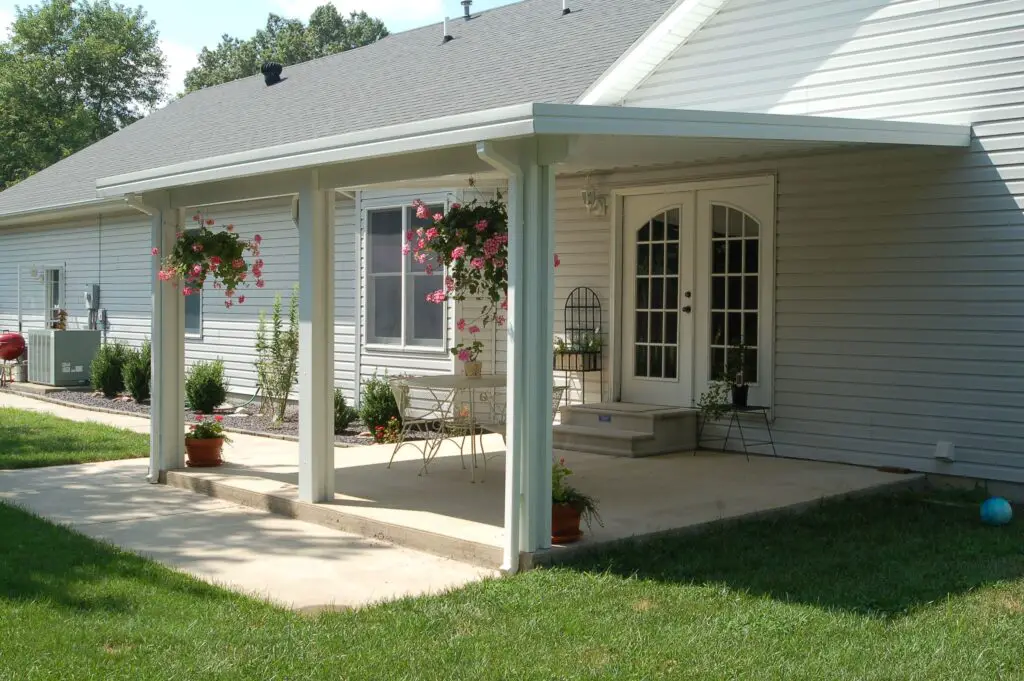
How do you cover a patio roof?
A patio cover can anything from a retractable awning to a pergola or a fixed roof. If you have a small patio with simple shading needs, you can buy or DIY a privacy screen, pop-up canopy, or free-standing umbrella.
The first step in covering your patio roof is meticulous planning and design. Consider the size and shape of your patio, the direction of sunlight, and how you want to utilize the covered space. Take measurements and create a rough sketch of the patio to visualize different roof styles and designs.
To support the patio roof, you’ll need to install sturdy support structures. This could involve erecting wooden posts, using metal beams, or attaching the roof to an existing wall of your home.
Construct the frame of the roof, using the material you’ve chosen. Ensure that the frame is level and properly anchored to the support structures. Depending on your design, you might need to use rafters and cross beams to create the desired shape and stability.
With the frame in place, it’s time to install the roofing material. Secure the chosen roofing material according to the manufacturer’s guidelines. If you opt for polycarbonate panels, be sure to seal the joints properly to prevent leaks.
Add any additional features or finishing touches to complete the patio roof. This could include gutter systems to manage rainwater, decorative elements, or lighting fixtures to create a cozy ambiance during the evenings.
Can you add a roof to a patio?
Professional Patio Roofs
A professional roofer should be hired if you want a full roof system with rafters, shingles, and gutters. They will be able to build a roof that follows all neighborhood building rules. Also, you’ll need to hire an electrician to wire and light up your new patio roof.
Solid Roof: A solid roof will cover your patio for good and won’t fall apart. It completely shields you from the sun, rain, and other bad weather. Solid roofs can be made from wood, metal, or shingles, based on the look you want and the cost you can afford.
Pergola: A pergola is a building with an open roof that is held up by columns or posts. It gives some shade and lets vines and climbing plants grow, which adds a natural touch of beauty to your porch.
A retractable awning is an open choice because it can be pulled out or put back up as needed. It protects you from the sun and light rain, and some types even have motorized controls to make it easier to use.
Shade Sail: A shade sail is a stylish and modern way to cover a patio. These fabric canopies come in triangles or rectangles and are stretched between anchor points. They provide shade and give your outdoor area a modern look.
Panels made of polycarbonate: These clear panels block UV rays while letting natural light pass through. They are easy to carry, won’t break, and are great for making a bright and welcoming covered area.
What is patio roof called?
Pergola
The word pergola has come to be used interchangeably with patio cover. An attached structure that provides shade and/or rain coverage for a patio or deck.
It gives the patio some shade and lets climbing plants and vines thrive, adding natural beauty. Pergolas are popular for stylish, attractive outdoor spaces.
A gazebo can cover an outdoor seating area or patio and is not just for patios. A freestanding, octagonal or hexagonal structure with a strong roof and open sides protects against the elements and offers a 360-degree outlook.
An awning is a patio roof that runs along a building’s exterior wall and provides shade. It can be retractable or fixed and constructed of cloth or other materials to shield sunlight and light rain.
Verandas are roofed, open-air galleries or porches linked to houses. It opens the residence to the outdoors and has a roof with columns or pillars.
In tropical and Hawaiian architecture, “lanai” refers to a covered patio or porch. Lanais, with roofs and screens to keep insects out, are popular outdoor living and dining facilities.
How high can a patio roof be?
Height depends on clearance from neighboring structures and the extent of the area you want to cover. It can be 2.4m to 3m tall.
Whether your patio roof is tied to your home or freestanding can affect its height. Attached patio roofs may have height constraints due to their interaction with your home, whereas independent constructions may have greater flexibility.
Construction must be set back from property lines in many areas. These setback rules may affect patio roof height. The height of a patio roof along the property line may be limited to avoid infringing on neighboring residences.
Beyond the legal restrictions, it’s essential to consider the aesthetics and overall design of your patio roof. An excessively high roof might overpower the outdoor space and not harmonize well with the surrounding landscape. Striking a balance between functionality and visual appeal is crucial when determining the height of your patio roof.
The height of a patio roof should also consider its structural integrity. Taller roofs may require more substantial support structures, such as taller posts or stronger beams, to ensure stability and safety. Engage a qualified structural engineer or contractor to assess the design and provide guidance on the appropriate height based on the materials and construction methods you intend to use.
What do you put on a patio roof?
You can cover your porch with a number of different types of materials. Outside fabrics, shade sails, wood pergolas, and structures made of metal and steel are just a few of these.
Cedar, oak, and other weatherproof woods are used. Wood shingles are popular in mild climates because they keep heat in and cold air out.
Steel, aluminum, and copper roofs are durable and weatherproof. They can be used in many ways because metal roofs come in standing seam, corrugated, and tile forms.
Polycarbonate panels are a lightweight and clear roofing choice that lets natural light in while blocking UV rays that can break down other materials. They can handle being hit, and they come in many colors and patterns to give your patio a modern look.
You could use cloth canopies or retractable awnings, which are more flexible and won’t break the bank. They protect you from the sun and light rain and give you shade. You can also change how much they cover as needed.
Thatch roofing gives your backyard a tropical and exotic feel. Eco-friendly thatch roofs built from dried grass or reeds retain heat. They prefer dry places and need frequent maintenance to prevent mold and decay.
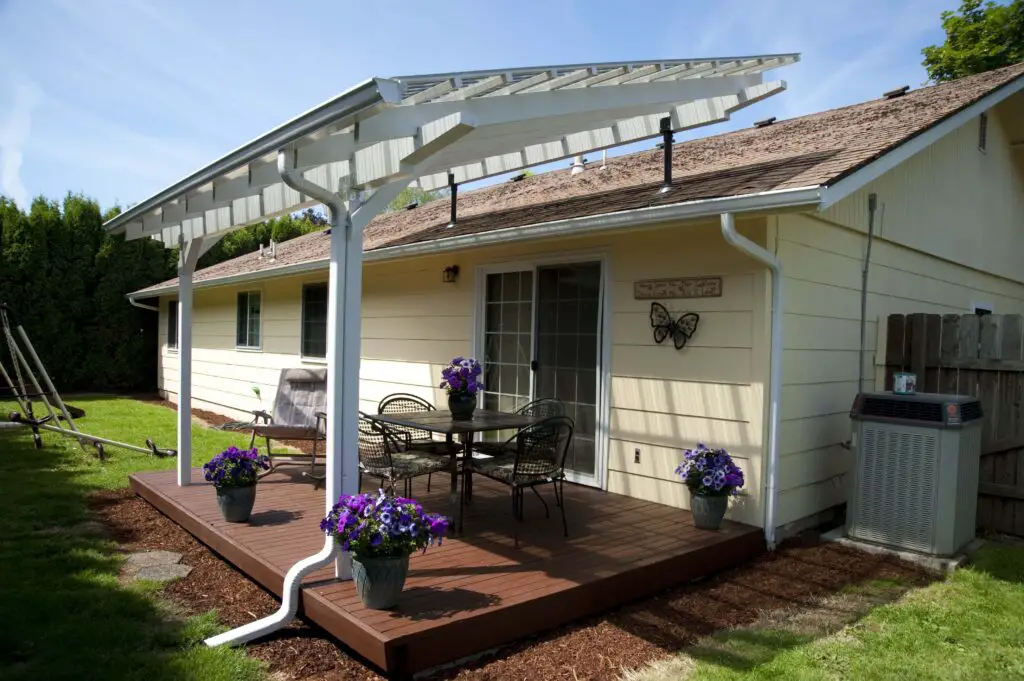
How thick is a patio roof?
Roofs can be 3″ to 6″ thick and made of either 1 1/2# or 2# density EPS (expanded polystyrene), based on the building code in your area. Roofs are made of thick gauge stucco-embossed metal that is protected by a Krystal Kote® finish that keeps it from getting scratches and discoloration.
If you choose a wood shingle or shake roof for your patio, the thickness will depend on the type of wood and the manufacturer’s instructions. Wood shingles or shakes can be anywhere from 3/8 inch to 1 inch thick. It’s likely that thicker shingles or shakes will last longer and keep your home warmer.
Metal roofing elements, like steel or aluminum, come in different thicknesses, which are usually shown by gauge numbers. It can be anywhere from 22 gauge, which is about 0.0312 inches, to 29 gauge, which is about 0.0142 inches. A smaller gauge number means the roof is thicker and will last longer because the materials are thinner.
Different sizes of polycarbonate panels are usually available for patio roofs. Usually, they range from 8mm to 25mm, which is 0.31 inches to 0.98 inches. The bigger panels are better at keeping heat in and are better able to handle damage from weather and impacts.
Traditional or tropical patio thatch roofs might be 3–4 inches thick. Thick thatch improves insulation and water-shedding.
How long does patio roof last?
Most insulated patio roofs have a lifespan of 15-20 years, depending on the materials used and the quality of installation and maintenance.
Metal roofs are known for their longevity and can last 40 to 70 years or more. Steel and aluminum roofs are durable, rust-resistant, and can withstand harsh weather conditions. Proper installation and periodic inspections can ensure they reach their maximum lifespan.
They resist impact and UV rays, although harsh weather and wear can shorten their lifespan.
Depending on fabric quality and maintenance, cloth canopies and awnings last 5–15 years.
Thatch roofing has a lifespan of around 15 to 25 years. The durability of thatch depends on the type of grass or reeds used and the quality of installation. Regular maintenance, such as rethatching when necessary, can extend its life.
Solar panels used as patio roof coverings typically come with a warranty that spans 25 to 30 years. While the efficiency of solar panels may decrease slightly over time, they can still provide energy for several decades.
How much weight can a patio roof hold?
How much can a roof hold when you sit on it? Many roofs can hold a nominal amount of 20 pounds per square foot and other roofs withstand the increased weight. For example, a roof with a rooftop deck can support 55 pounds of weight per square foot.
Weight-bearing capacity depends on the patio roof’s structural design, including post and beam size and spacing. The roof will be stronger with pressure-treated wood, steel, or aluminum framework.
Different roofing materials weigh differently per square foot. Asphalt shingles weigh 2.5–4 pounds per square foot, while metal roofing weighs 1–5 pounds. Lightweight polycarbonate panels weigh 0.3 to 0.75 pounds per square foot.
In areas with high snowfall, the patio roof must be designed to accommodate the extra weight. Regional building codes set snow load capacities for structures.
If you reside in a windy environment, consider the patio roof’s wind load capacity. The roof must be well-anchored to withstand wind’s lateral force.
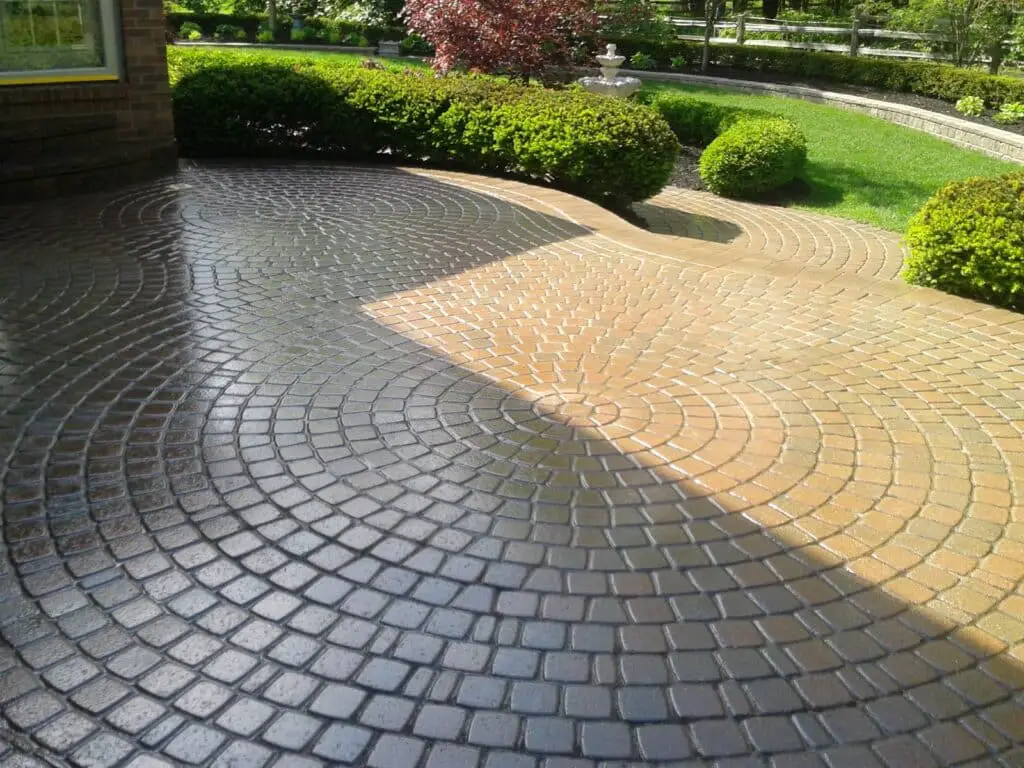
Conclusion
Throughout this journey, we have equipped you with the knowledge and confidence to transform your outdoor space into a haven of comfort and functionality. Building a patio roof is a gratifying project that allows you to enjoy your patio year-round, regardless of the weather, while adding value and charm to your home. Remember, as you begin the construction process, it is essential to take your time, follow the instructions diligently, and seek assistance if needed. Safety should always be a priority, so do not hesitate to consult professionals if you encounter any uncertainties or challenges along the way.
By carefully considering your design options, assessing your patio roof structure, and understanding local regulations, you have taken the essential first steps to ensure a successful and safe construction process. Armed with the right tools, materials, and construction techniques, you are now ready to embark on this exciting DIY adventure. Embrace the creativity and joy of the construction process, and before long, your patio will become a captivating retreat that enhances your lifestyle and brings joy to all who visit.
As you raise the framework and see your patio roof take shape, you will undoubtedly feel a sense of pride and accomplishment in your handiwork. Soon enough, you’ll be able to enjoy the fruits of your labor, making cherished memories under your new patio roof with loved ones. We hope this guide has been a valuable resource, providing you with the inspiration and practical knowledge to create a beautiful and functional roof over your patio.



